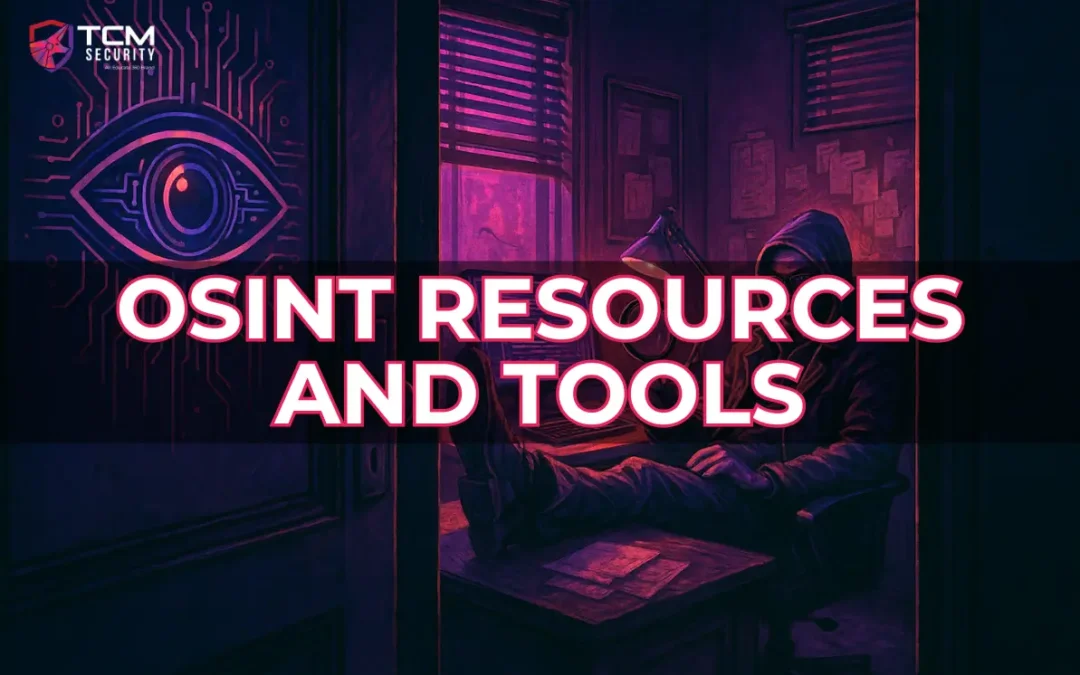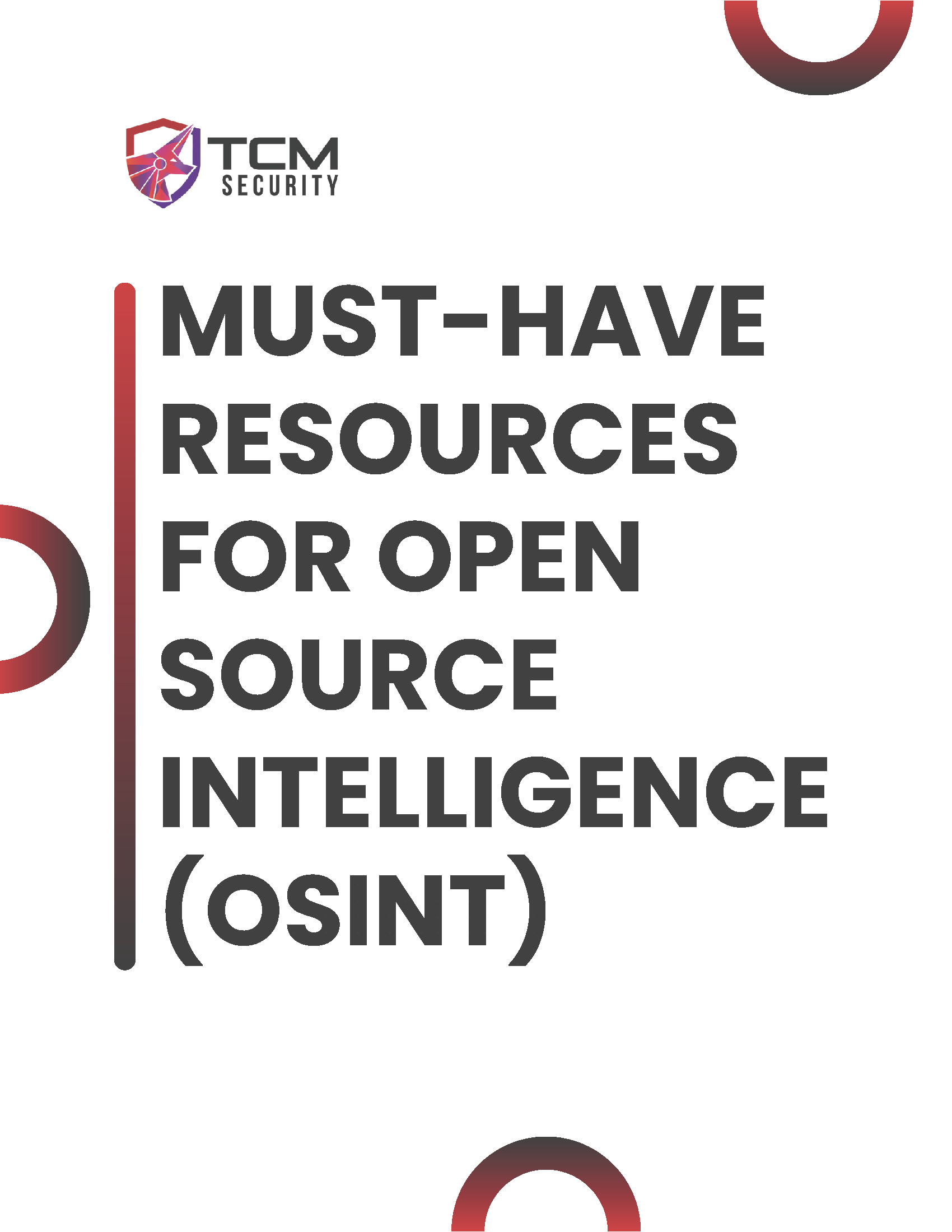As our personal lives, businesses, entertainment, and communities move deeper into digital spaces, various levels of Open Source Intelligence (OSINT) have become commonplace. From verifying a suspicious social media account to conducting a highly targeted phishing campaign, OSINT plays a vital role in everyday life as well as cybersecurity operations.
For both offensive and defensive professionals, mastering OSINT isn’t just an advantage, it’s becoming more of a requirement. This post explores some of the fundamental domains of OSINT and tools to develop this discipline as a cyber security professional.
If you are interested in taking a deep dive into professional OSINT methodology and how to best use the following tools and techniques, consider the OSINT Fundamentals course on the TCM Academy. The Practical OSINT Research Professional is a real-world examination of your cyber sleuthing abilities and a way to demonstrate your prowess.
Understanding OpSec
Operational Security (OpSec) is the discipline of minimizing the data trails that reveal who you are, what you’re doing, and what you know. For cybersecurity professionals, OpSec is both a shield and a lens. It helps you stay safe while performing investigations, and it enables you to understand how adversaries might uncover information about your organization or clients.
Online anonymity requires intent. Even digital natives, who grew up online, can slip: an old username, a neglected blog, or a forgotten forum post can lead investigators straight back to an identity. The Silk Road takedown is a well-known example where tiny fragments of digital history helped to identify the site’s creator. The takeaway: your past online behavior can remain part of your digital identity long after you’ve forgotten about it.
The Digital Past Is Always Present
The Internet never truly forgets. The Internet Archive alone has preserved over 900 billion web pages, creating a staggering memory bank of humanity’s digital footprint. That old company press release, employee directory, forum post, or product manual might still be accessible even if you’ve taken it down.
Understanding that every digital input on the World Wide Web is likely discoverable is an important personal lesson, but one that is easily forgotten with the one-click ease of posting information. It can also create opportunities for malicious actors to use for social engineering, data breaches, and other nefarious activities.
Offensive and defensive cyber security professionals must be aware and well-versed in these tactics to better protect themselves and their clients.
OSINT Tools List
Sock Puppets (Ethical Identities for Testing)
A sock puppet is a crafted, false digital persona, and can be an invaluable tool for reconnaissance and social engineering. Used ethically (and within scope), it allows pentesters and red teams to interact with targets just as threat actors would. A convincing sock puppet has realistic history, tone, and connections. Blue teams should study these tactics too, since spotting fraudulent personas is a crucial defense skill.
Here is a well-thought-out and thorough, but doable, process for creating a digital sock puppet: https://www.reddit.com/r/OSINT/comments/dp70jr/my_process_for_setting_up_anonymous_sockpuppet/
Search Engines: Advanced Operators
Search engines handle billions of queries daily, yet few users tap into their real potential. Mastery of search operators (site:, filetype:, intitle:, inurl:, ””, among others) turns a basic search into a targeted intelligence tool. With these, professionals can uncover exposed configurations, sensitive PDFs, login portals, and credentials in the wild. Think of Google as a reconnaissance interface, not a convenience feature.
Here is a handy cheat sheet of search engine operators:
https://static.semrush.com/blog/uploads/files/39/12/39121580a18160d3587274faed6323e2.pdf
Social Media OSINT
Many people have become self-taught experts in this domain, as demonstrated by a recent SNL skit where two young ladies solve several cold cases with their smartphones and social media sleuthing (no link, since YouTube can be an attention trap, but shouldn’t be hard to find “Detectives SNL”). The way that they effortlessly pivot through mutual connections and fake accounts is a little less hilarious once you realize how on the nose it actually is. Posts, likes, friend lists, geotags, and event check-ins can reveal routines, affiliations, or professional dynamics.
Gathering intelligence has never been easier with so many platforms, plus the proliferation of smartphones. Even those who are serious about their OpSec can be swept up in the constantly running documentary of those around them. With a thorough methodology and some time and persistence, you can find a surprising/scary amount of information.
Here are a couple of tools to make gathering intel on social media platforms more efficient:
Image OSINT
A picture is worth a thousand words… and often, dozens of metadata fields. Beyond the visible content, images can contain EXIF data revealing GPS coordinates, device models, timestamps, and more. Reverse image searches can connect one photo across multiple platforms, allowing for the correlation of identities. For red teams, this supports identity linking and pattern recognition; for blue teams, it reinforces why removing metadata is essential for privacy.
Besides the backend data, an image itself is also full of information. Take a look at this video demonstration of Heath Adams walking through his manual image OSINT methodology, along with a few of the tools he uses.
Email OSINT
Email addresses have several functions for red team operators and are one of the easiest entry points into a target’s ecosystem. Tools can validate which email accounts exist for a given domain, cross-reference them with breach databases, and help identify potential phishing targets. In ethical engagements, this informs how a threat actor might enumerate and exploit the same data.
On defense, tightening SPF/DKIM/DMARC configurations and reducing public exposure mitigate these risks.
Here are some email validation tools we like:
Username OSINT
Reused usernames are an OSINT treasure. Finding user names helps with creating a map of accounts and developing a more complete dossier for a user, such as one handle being used across forums, gaming sites, and professional networks. For attackers, it’s a pivot to new platforms, and if this avenue exists, it should be a finding for offensive professionals. For defenders, it’s an opportunity to identify impersonation attempts and prevent doxxing.
Here are a few tools for finding usernames across domains and platforms:
Password OSINT
Compromised credentials are the backbone of many attacks since, in many cases, they can be easily attained, are less visible, and require less effort than more sophisticated methods. To this day, weak technical controls in some organizations still allow passwords for sensitive accounts that can be brute-forced in a relatively short amount of time, but with some OSINT, spraying a likely password across a big enough organization will usually score some legitimate credentials.
Data dumps of breached credentials are going to be used by legitimate threat actors, so knowing where to find exposed passwords and how to use them during a penetration test is a skill you want. It can also be helpful for identifying password patterns among organizations or individual users.
Here are some tools for investigating breach data for credentials:
The Line Between ‘OSINT’ and ‘Intrusion’
Because OSINT relies on public information, it’s often mistaken as “always legal.” That’s not entirely true. Activities like scraping restricted systems, impersonating individuals, or accessing private data without consent can cross ethical and legal boundaries fast. Professionals must operate under authorization and within clear legal frameworks. In short: if it’s not public or permitted, don’t touch it.
Final Thoughts
OSINT compresses decades of espionage tradecraft into accessible, automated techniques. It’s the digital age’s equalizer, giving both adversaries and defenders access to the same open data. Offensive professionals rely on it to identify weaknesses before attackers do; defenders depend on it to close those same gaps.
Used responsibly, OSINT strengthens security awareness, empowers incident response, and helps build more resilient systems. Used recklessly, it becomes exploitation. The difference lies in intent and permission. For anyone pursuing a career in cybersecurity, OSINT isn’t just another tool. It’s the foundation of understanding how the modern threat landscape truly works.
And again, if you are looking for training in how to conduct OSINT in a professional capacity, try the OSINT Fundamentals course at the TCM Academy and certify with the Practical OSINT Researcher Professional certification exam.
Additional Resources
How to Be an Ethical Hacker in 2025
Interested in a career in ethical hacking or penetration testing? This guide walks you through the essentials you need to learn to break into the field.

Must-Have OSINT Resources
Gathering information from publicly available resources can help you access a network or exploit a web app.
About the Author: Josh Daniels
Josh is an avid storyteller and writer who loves learning about the behind-the-scenes of the digital world we live in. While his professional experience is in content marketing, Josh began pursuing a career in cybersecurity in 2022, gaining a Sec+ certificate along with other training from industry professionals and a life long learner attitude.
When he is not writing, Josh enjoys outdoor adventures with his family, watching movies, reading, and an unofficial (unpaid) side gig as a Game Master Consultant for several friends who play table top RPGs. At TCM, Josh has found a home where his passion for storytelling and cybersecurity meet.
“Once men turned their thinking over to machines in the hope that this would set them free. But that only permitted other men with machines to enslave them.”
– Frank Herbert
About TCM Security
TCM Security is a veteran-owned, cybersecurity services and education company founded in Charlotte, NC. Our services division has the mission of protecting people, sensitive data, and systems. With decades of combined experience, thousands of hours of practice, and core values from our time in service, we use our skill set to secure your environment. The TCM Security Academy is an educational platform dedicated to providing affordable, top-notch cybersecurity training to our individual students and corporate clients including both self-paced and instructor-led online courses as well as custom training solutions. We also provide several vendor-agnostic, practical hands-on certification exams to ensure proven job-ready skills to prospective employers. Pentest Services: https://tcm-sec.com/our-services/ Follow Us: Email List | LinkedIn | YouTube | Twitter | Facebook | Instagram | TikTok
Contact Us: [email protected]
See How We Can Secure Your Assets
Let’s talk about how TCM Security can solve your cybersecurity needs. Give us a call, send us an e-mail, or fill out the contact form below to get started.


